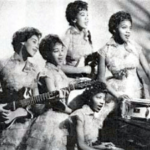
About
Original Members (1950s):
Millicent “Sonia” Goring
Lois Harris
Jackie Landry
Renee Minus
Arlene Smith
Formed in the Bronx, New York in the early 1950s, the Chantels were among the first African-American female vocal groups to gain national attention. The group originally brought together the five voices of Arlene Smith (who typically sang lead), Lois Harris (first soprano), Millicent “Sonia” Goring (second soprano), Jackie Landry (first alto), and Renee Minus (second alto). The girls were all raised in the Bronx, and they first met and discovered each other’s musical abilities as members of the St. Anthony of Padua Church Choir, in which they mainly sang Catholic liturgical music. They would practice daily after school, and their parents were generally supportive of their efforts.
A chance run-in with Richard Barrett of the Valentines helped earn the group a record deal with End Records in 1957. Barrett continued to act as a manager to the group. The Chantels produced their first single “He’s Gone” later that year. “Maybe,” released December 1957, scored them their first and biggest hit, reaching #15 in the pop chart and #2 in the R&B chart. It became the first record by a girl group to sell over a million copies and was certified gold. The group began working more seriously on professionalization, working with Charles “Cholly” Atkins, later the choreographer for Motown, on their dance and movement. Renee Minus also recalls finally finding cosmetics companies that would produce professional products for black skin and receiving styling help from LaVern Baker’s assistant. The Chantels also began to experiment with playing instruments as part of their act: Harris played the piano, Goring and Landry guitar, and Smith the bass. The group’s success continued as they toured nationally, including with Alan Freed, and appeared on major television programs isuch as American Bandstand and the Dick Clark Show.
Subsequent releases did not quite attain the same sales as “Maybe,” prompting End Records to drop the Chantels in 1959, but differences in career goals were already creating tensions in the group. Arlene Smith embarked on a solo career, and Lois Harris started college. In 1961, the Chantels released “Look in My Eyes” with Carlton Records which hit no. 14 on the pop charts and no. 6 on the R&B charts. Since then, the Chantels have re-formed with different line-ups, and the name remains one of the best-recognized of the girl groups.
While they only had a small window of recording success, the influence of the Chantels can still be heard today. “Maybe” is an essential song in the rock and roll songbook with notable covers by the Third Degrees, the Red Hot Chili Peppers, and Janis Joplin. The Chantels received the Rhythm and Blues Foundation’s “Pioneer Award” in 1996 and have twice been nominated for induction into the Rock and Roll Hall of Fame (1999, 2010). Renee Minus (now Minus White) writes in her autobiography: “Arlene and Sonia are licensed teachers, Jackie was a court reporter. Lois works as a licensed nurse practitioner, and I am a journalist and licensed real estate broker. I am so proud of our efforts and achievements.”
“He’s Gone” / “The Plea.” End E-1001 (1957).
“Maybe” / “Come My Little Baby.” End E-1005 (1957).
“Look In My Eyes” / “Glad to Be Back.” Carlton 555 (1961).
Lauren Nowicki, “Beverly Montez Remembers Her Chantel Years,” Herald Statesman (New York), 25 May 1982.
Renee White, Maybe: My Memoir, An Original Member of the Chantels (Rosedog Press, 2015).
David Hinckley, “Proper Young Ladies: the Chantels,” Daily News (New York), 1 June 2004.
Jacqueline Warwick, Girl Groups, Girl Culture: Popular Music and Identity in the 1960s (New York: Routledge, 2007).
